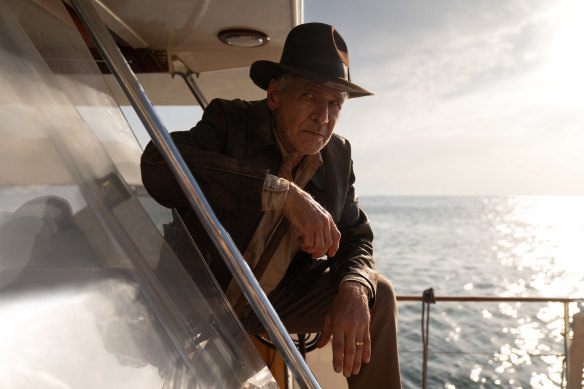Save articles for later
Add articles to your saved list and come back to them any time.
Indiana Jones And The Dial Of Destiny ★★★½
(M) 154 minutes
They say you can’t turn back the clock, but Walt Disney Pictures would appear to be betting otherwise with the high-priced Indiana Jones and the Dial of Destiny, the first adventure in 15 years for the irritable yet intrepid professor of archaeology, played once again by the now 80-year-old Harrison Ford.
In Dial of Destiny, Indiana Jones (Harrison Ford) may be older and slower, but he’s a more rounded character than in previous films. Credit: Lucasfilm
Our first glimpse of Indy back in action is disconcerting in multiple respects. For one thing, he has the unnaturally smooth-faced look of the digitally de-aged. For another, he’s battling to stay ahead of the Nazis in the last days of the Second World War – bringing him uncomfortably close to real-world history, which in previous Indy romps was at most something you might glimpse out of the corner of your eye.
Thankfully, this is mere prologue to the real adventure, which kicks off in 1969, with Indy in full grumpy-old-man mode as hippie students snore through his class. Forced to postpone a well-earned retirement, he’s soon jetting off for Tangiers to reclaim the dial of the title, an ancient artefact said to have the power to turn back time in a literal sense.
Joining him is his British goddaughter, Helena Shaw (Phoebe Waller-Bridge), the kind of fearless minx the girls of St Trinian’s might hope to grow up to become. Her breezy amorality is an unflattering mirror image of Indy’s own – but she may have a streak of decency in her somewhere, at least compared to rival treasure hunter Jurgen Voller, a once and future Nazi scientist played slightly too likeably by Mads Mikkelsen (his running gag is that events keep mussing his carefully arranged hair).
This is the first big-screen Indiana Jones adventure not directed by Steven Spielberg or dreamt up by Spielberg’s old pal George Lucas (both remain as executive producers). Picking up where they left off is James Mangold (Logan), a versatile talent who seizes the chance to reflect on and revise what has come before.
Spielberg’s approach was all about momentum, speeding along, so we never had much of a chance to ponder what we were shown. Mangold doesn’t stint on hectic chase sequences and hair’s breadth escapes, but he’s determined to add a little more weight: he’s fond of low angles and tight close-ups in which all the characters loom as potential monsters.
This heaviness and self-consciousness entails a sense of loss – but that’s something we’d likely feel regardless given the passage of time, which emerges as the film’s central and explicit theme. The Indy of Dial of Destiny is older and slower but also a more rounded character than previously, whose testy manner masks not just weariness and regret but heartfelt grief.
Ford as an actor is typically allergic to sentimentality, but it’s precisely his emotional restraint that ensures he’s able to move us when he needs to. One further course correction probably helps: where Indy was until now among the most ruthless of movie heroes, Mangold discreetly ensures that on this occasion, he racks up a far lower body count.
Indiana Jones and the Dial of Destiny is in cinemas from June 29.
Find out the next TV, streaming series and movies to add to your must-sees. Get The Watchlist delivered every Thursday.
Most Viewed in Culture
From our partners
Source: Read Full Article







